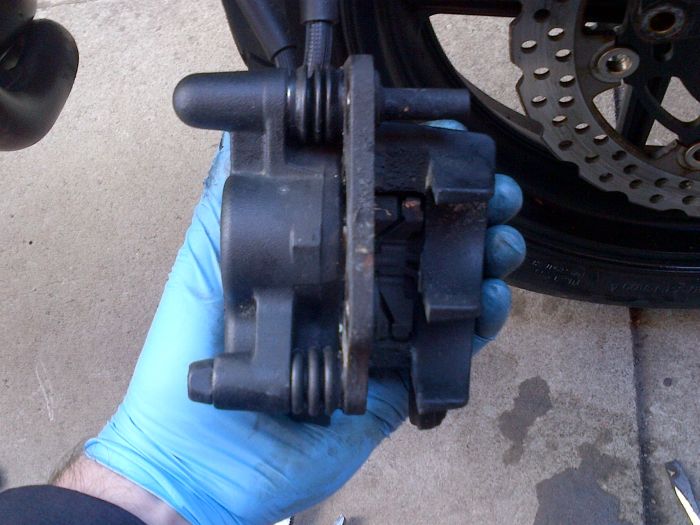Like me, some of you have been using your bike on and off during the winter and may have noticed a slow degradation in brake performance or the bike needing more effort to wheel around when parking up. This might go unnoticed if you have had your bike in storage over the winter months and go to get it out of hibernation in the spring.
If so, it’s time to give the calipers a bit of a clean. The following is my own personal method so feel free to find a method that works for you.
Along side my trusty tool box, I look out the following items for this task:-
- 1 tub of cotton buds / q-tips
- 1 small container of brake fluid labelled “for brake cleaning only”
- 1 pair of plumbers pliers/G-clamp or similar.
- 1 handfull of rags
- 1 box of nitrile gloves (to protect my soft hands from nasty chemicals)
- brake cleaner spray (I use a [amazon_textlink asin=’B00N3YHXP0′ text=’ refillable Wurth pump bottle & cleaner ‘ template=’ProductLink’ store=’aberdeenbiker-21′ marketplace=’UK’ link_id=’fc6b34fe-0c19-11e8-8fb2-09d301251dbe’] rather than aerosols)
- 1 spare spanner with a body longer than your brake pads and a similar thickness to your disks (degrease spanner with brake cleaner before use)
- if you have 4 pot brakes then some sort of g-clamp or similar is handy for preventing the pistons you are not working on extending too far.
Give the bike a wash first to remove as much loose dirt from the bike as you can.
Only remove one caliper at a time. Once the retaining bolts have been removed then hold the body of the caliper the carefully rotate it against the disk to push the pistons in slightly and allow the pads to slide past the disk (if your disks are work then they may have a lip at the edge which the pads will need to get past).
With the caliper removed I first slide the pads away from the piston(s) then give them a blast with some brake cleaner spray to remove any loose dirt.
Then slide the pads back out to the sides and place the clean spanner between the pads. Carefully and slowly pump the brake lever to extend the piston(s) a couple of mm. The spanner is only there to prevent you accidently over extending the pistons and should not be squeezed hard by the pads. It will also allow you to push the pistons back in by using it to lever against the pads.
Working one piston at a time, dip a clean cotton bud into the brake fluid and gently clean the exposed sides of the pistons. At this time you may want to remove the pads to give better access all around the pistons. Inspect each of the pistons for signs of corrosion.  Also look for signs of the rubber dust seal starting to bulge out between the piston and the caliper (see picture). This will indicate that dirt, most likely crystalised salt, has got behind the dust seal and is driving the seal out from inside the caliper.
Also look for signs of the rubber dust seal starting to bulge out between the piston and the caliper (see picture). This will indicate that dirt, most likely crystalised salt, has got behind the dust seal and is driving the seal out from inside the caliper.
If this is the case then you are looking at replacing the caliper seals which I may cover in another post in the future.
Once you have cleaned the pistons with the brake fluid and cotton buds then give them a quick blast with the brake cleaner spray again to remove any excess brake fluid. It can sometimes be easier to do this by popping the pads back in place before attempting to push the pistons back into the calipers.
Depending on how easy your pistons are to move you may be ably to just twist the spanner inbetween the pads to put enough pressure on the pads to retract into the caliper. If not that’s when you may have to use the plumbers pliers with the ends wrapped in rags to “ease” the pistons back into the body of the caliper.
If you have sliding type calipers such as the one shown below then you want to make sure that the caliper is free to move along the slide pins. (a sliding caliper will only have piston(s) one one side of the caliper)

If you have sliding calipers, like mine, the metal part on the right hand side of the rubber gaiters/boots should slide from side to side with finger tip pressure. If it doesn’t then possibly one or both of the gaiters has failed allowing muck and salt inside which builds up on the slider causing friction. However, the more likely problem is that salt and muck that has got between the bottom gaiter and the hole in the caliper body that the gaiter/boot passes through. Water carries the salt and grime into the space where it dries out and crystalises effectivly reducing the diameter of the hole in the caliper which causes the rubber of the gaiter/boot to press on the sliding pin making it hard to move.

The only choice you have there is to carefully remove the gaiter/boot and clean up it and all the muck from inside it’s mounting hole as per the photo below. To remove it, carefully stretch out the bellows part and fold it over on itself to reduce its diameter. You should be able to withdraw it easliy from the other side.

Clean out the hole in the caliper removing all the built up lumps of grime and salt. Once cleaned up you can then carefully replace the gaiter (easier said than done so take your time). I carefully use some ACF-50 on the rubber to lubricate it and neutralise any remaining salt and apply ACF-50 to the corresponding hole in the caliper body.
Then all is left is to replace the slider, pads, and re-attach the calliper. Please remember to install the pads the correct way round with the friction material of each pad pointing together!!!!!!
Remember to pump your brake levers and test the brakes before riding and your brakes should be working properly again.
At any time of year, if you find that your brakes are betting a bit spongy then I would recommend cleaning your pistons and making sure they are all free to move before people start going on about changing brake lines etc. If your pistons aren’t free to move then what good are braided lines going to be except an additional expence!
If your back brake still feels like it is stiff then make sure you check that the brake lever itself is free to move. This caught me out recently and it was only the brake light staying on that drew my attetion from the caliper to the brake lever. On inspection it was very stiff. I stripped the mechanisim and re-greased the lever to restore normal operation. Something I will add to my check list now for future maintenance.
Al.





